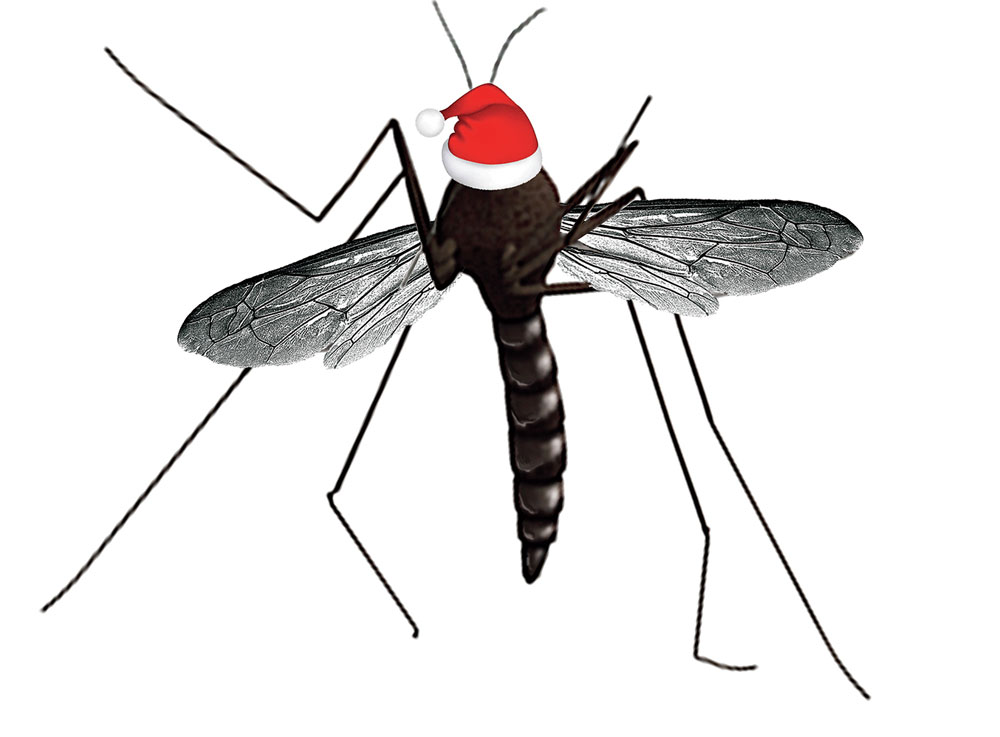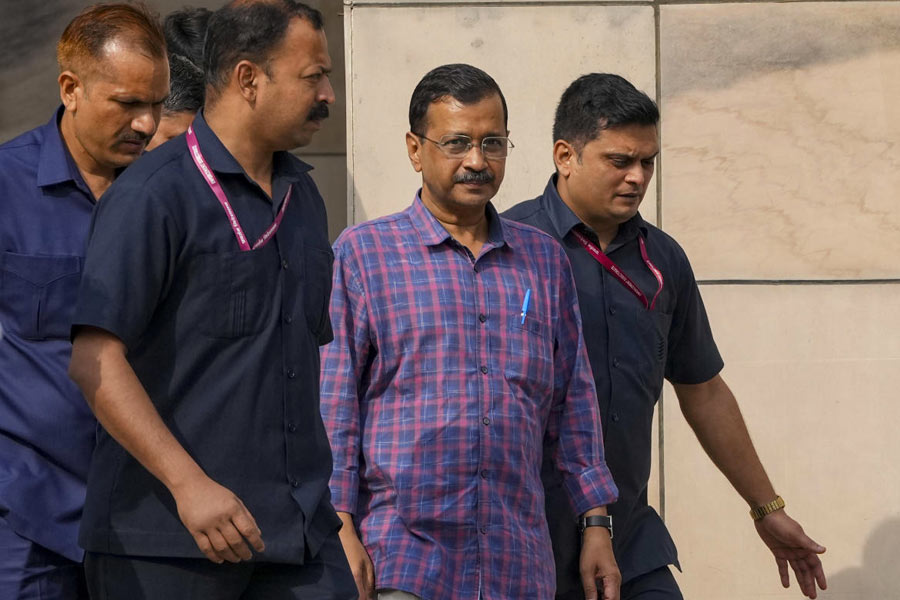Gunga got his name from a young British journalist by the name of Rudyard Kipling. Sometime in the late 1880s, Kipling was visiting the city, when he stopped by at this cemetery too. Later, in the City of Dreadful Night he wrote: “The tombs are small houses... men must have been afraid of their friends rising up before the due time...”
As Kipling explored the cemetery grounds, a brattish young anopheles got his ear and attention. Zzzzzz, zzzzzZ he kept going in a loop — dodging the sahib’s white fingers as he tried to swat him, tickling his nose, getting beneath his spectacles. The male of the Anopheles doesn’t bite humans, a job best left to the female of the species, but it does make a lot of din as its powerful little wings beat 450 to 600 times per second. At one point, the sahib cried out exasperatedly — “Din. Din. Din.” Jottings done, when he turned to go, addressing the air behind him, Kipling said crisply: “’Twas nice meeting you, Gunga Din.”
Now, male mosquitoes live for a maximum of 10 days. The females, for about six to eight weeks. Gunga Din died within days of Kipling’s departure, but the act of nomenclature, no matter how casual, tinkered with some karmic routine and Gunga Din found himself confined to earth.
Today, Gunga Din cannot remember what those initial years of ghosthood were like, until he met Ronald Ross. In the interim years, the cemetery had come to be a bit more crowded. In her paper, Death in India, 1871-1921, researcher Ira Klein observes that the period between the late 19th and early 20th centuries “witnessed a woeful crescendo of death”. She writes, “Malaria was the greatest destroyer of lives; according to the most reliable figures it accounted for almost one death in every five. From the mid-1890s to 1921 it probably took twenty million lives.” Medically unsophisticated village constables and clerks, however, listed most such deaths as caused by fever.
Bengal was one of the worst affected geographies. In another paper, Malaria and Mortality in Bengal, Klein notes that by the 1840s the British had started to try and pin down the cause of the fever. T.E. Dempster, a surgeon with the Horse Artillery and a member of the canal committee, cited “the astonishing difference between the number of fever cases belonging to the irrigated and unirrigated parts of the region of the West Jumna canal”. It was observed that where soil conditions and drainage were favourable, malaria had not taken hold. Others perceived a link between road construction and malaria. An inquiry committee was set up in 1863 and the Indian member, Raja Digamber Mitter, pointed out how in a continuous line of villages, a severe type of fever broke out exactly at the same time the railway embankment progressed and passed along the eastern borders. Klein explains what was happening was that developmental work tended to multiply conditions favourable for breeding malarial mosquitoes — stagnant pools of water — and in the engaged labour force, the mosquitoes found a vast susceptible population. And when the workers dispersed, they carried the infection with them into the heartland.
But malaria and other mosquito-borne diseases were not peculiar to Bengal or India, nor typical of the 19th and 20th centuries. They had existed possibly since the beginning of creation. The oldest known mosquito with an anatomy similar to modern species was found in a 79-million-year-old Canadian amber from the Cretaceous — the last phase of the Mesozoic era, post the Jurassic. In Mosquito: A Natural History Of Our Most Persistent And Deadly Foe, Andrew Spielman and Michael D’Antonio write about Pope Gregory the Great (590-604 AD) and his musings about the mosquito problem and how many later pontiffs refused to sit in Rome for this reason. In the Middle Ages, entire armies were laid low by Italian mosquitoes. Dante wrote about its symptoms. Alexander the Great was felled by it and mosquitoes, in all likelihood, prevented Genghis Khan from invading western Europe.
Gunga Din, of course, was not aware of the magnitude his lot was wreaking and had wreaked on mankind. Not then, at least. It was from the whispers of the new inmates of the cemetery that he heard of the British doctor working at the Presidency General Hospital (present day SSKM). The whisper was that he was slightly touched in the head, moved about in odd places with a man and an empty bottle looking to catch mosquitoes. To this day, Gunga Din does not know what possessed him to venture out of the cemetery in search of the doctor, but he did. Every day for the next many months he tailed Ross. Ross working out of Surgeon-Lieutenant-General Cunningham’s laboratory. Ross with his man, Mahomed Bux, releasing dappled mosquitoes and birds inside holeless mosquito nets.
It is known from Ross’s Memoirs that it was in 1883 that he got interested in mosquitoes. He wrote: I messed at first with the 4th Madras Pioneers [in Bangalore]… That was the first time that I became interested in mosquitoes. They devoured me in our bungalow until I discovered that they were breeding in a tub just outside my window, when I rid myself of nearly all of them simply by upsetting the tub…” When Ross suggested to the military officer that this seemed like a good way to clear out all mosquitoes, the latter was scornful. Ross writes, “I did not know then that this type of fool is very common indeed.”
Gunga Din had taught himself the English alphabet at the cemetery from browsing the many epitaphs. The experience now came in handy as he pored over Ross’s correspondences and diary entries. He gathered that even before he had arrived in Calcutta, when he was in Secunderabad, Ross had established a connect between malaria and the mosquito.
On August 20, 1897, he confirmed the presence of the malarial parasite inside the gut of the mosquito. During his stay in Calcutta, he discovered the method of malaria transmission. He was now sure that the salivary gland of the mosquito was the storage site of the parasites and these were released during the act of biting.
Gunga Din remembered a poem Ross wrote to his wife the day he had his eureka moment. It had been composed when Ross was in Secunderabad but Gunga Din found it among his journals. “This day relenting God/Hath placed within my hand/A wondrous thing; and God/Be praised. At His command,/Seeking His secret deeds/ With tears and toiling breath,/I find thy cunning seeds,/O million-murdering Death…” The recantation of the poem reminded Gunga Din of MyDear once again.
In mosquitoes, it is the females that prey on human blood. Not on whim, but to fuel production of eggs. Most other mosquitoes feed on nectar or other sugar sources. MyDear had been an exception; she did not like the taste of blood. And that is how she and Gunga Din had met and gotten to know each other, instead of the usual mechanical mating and leaving so typical of the species. Of course, he did not have a name for her then. It was much later while buzzing around Ross’s papers that Gunga Din discovered that his wife was called MyDear. There were all those letters addressed to her. Mosquitoes don’t marry, they mate. But Gunga Din told himself if he had a wife it would have been MyDear and he would have liked to call her that.
Gunga Din and MyDear didn’t have any children. A female mosquito can lay a set of up to 100 eggs about every third night after mating only once. She can lay as many as three sets before dying. But MyDear was of a different sensibility. “To what purpose,” she had asked Gunga, when they discussed raising a family and then deliberately oviposited on a dry patch, where the eggs had next to no chance of survival.
Depending on which species they belong to, mosquitoes bite at a certain time of the day. The malaria-inducing Anopheles is active post sundown and indoors. The dengue transmitting Aedes aegypti is active primarily during the day. Depending on the species, mosquitoes attack a certain part of the body and not others. Spielman and D’Antonio write in 2001: “Aedes aegypti is a very sneaky mosquito that prefers to come in low and bite people on the ankles or calves. This attack mode explains a habit called the Babu Bounce that is practiced by so many secretaries in India. They jiggle their legs up and down almost continually to ward off this little mosquito.” One I.H.T. Roberdeau, who was the assistant collector of Mymensingh, has written about the Indian mosquito, each of which was the size of a gnat, and attacked the face to deformity. “…what a visage!! … a plum pudding stuck full of red berries,” he wrote in an essay titled A Young Civilian in Bengal in 1805.
In the 1855 Reminiscences of an Indian Journalist, a William Knighton writes, “…if you have the misfortune to wear shoes, they [mosquitoes] will soon discover the fact and settle accordingly on the instep and by the side of your foot — they prefer the fleshy portion. By skilful manoeuvring of your feet, however, you easily detach them or prevent their settling effectually, that is by gliding one foot over the other, softly and leisurely, as if you meant nothing in particular…”
All these years later, humans still cannot fathom how to tackle the mosquito or give it the slip, Gunga Din thinks and chuckles. He remembers those photographs of mosquito nets from army and navy catalogues in 1905. Quinine was widely used and thereafter, around the time of World War II, chloroquine and DDT emerged, then came pyrimethamine, mefloquine, artemisinin. The weaponry changed from spray to coil to mat to dispensers. On an even larger scale, there are talks of gene editing — something to stem procreation of mosquitoes. Gunga Din knows all this and more. A smartphone a cemetery visitor forgot behind one of the tombstones has opened new vistas, turned him into an expert.
A simple Google search reveals that even as political parties and nations train their guns on each other, globally the common war being fought is that against the mosquito — Muscat, Miami Dade County, Burkina Faso, Phuket, Calcutta, Rajasthan. The Bill and Melinda Gates Foundation has prioritised malaria in its commitment to fight infectious disease in developing countries. Google’s parent company, Alphabet Inc., is working to eradicate diseases spread by mosquitoes. Verily Life Sciences, a subsidiary, is reportedly releasing swarms of male Aedes aegypti mosquitoes infected with a bacterium that causes their offspring to never hatch.
Thinks Gunga Din, not for nothing did that Kipling fellow write that famous line — “You’re a better man than I am, Gunga Din!”
Better, stronger, definitely stronger.
Gunga Din sits in one corner of a cemetery in central Calcutta and watches the youthful swarm attack the honeysuckle bushes lustily. Though in reality the December chill cannot touch Gunga, he shivers out of habit. Today is a chilly day by Calcutta standards — 18° Celsius. It has been drizzling too since morning. In the olden days, by now temperatures would have plummeted to 7 or 8°C. Gunga and the boys wouldn’t last two seconds in such weather. MyDear and the girls would go to sleep for a couple of weeks. The girls today are more ferocious, even more hardy, Gunga notes, chuckling to himself.
Gunga Din is an Anopheles mosquito from the Raj days. Or was — for now he is just a benign phantom watching over his kind prosper. According to a World Health Organization (WHO) report, in 2015 malaria alone caused 4,38,000 deaths worldwide. Recent studies have identified patients in India infected with malarial parasites resistant to a key last-line drug; all of them are in Bengal. Between September and November this year, over 280 cases of Zika virus infection were reported from three states alone. And here in Calcutta, when the new mayor took charge some weeks ago, Gunga and his ilk were part of his mission statement, rather a claim to their annihilation was. Firhad Hakim had thundered: “To control dengue outbreak, we have to launch a massive awareness campaign among citizens. We have to make them aware to not keep places unhygienic and dirty, as such places become breeding grounds for mosquitoes.” The same WHO report states that the worldwide incidence of dengue has risen 30-fold in the past 30 years. Malaria, Zika and dengue are all mosquito-borne diseases. They are caused by Anopheles, Aedes and Aedes aegypti, respectively. Chikungunya is caused by Aedes aegypti and Aedes albopictus. And these apart, there are more than 3,000 species of mosquitoes.











